Who Is Robert Taylor?
Inter Miami have never really been a giant of the MLS.
In fact, prior to Lionel Messi’s arrival from Paris Saint-Germain, you could even argue they’ve been on a downward spiral; a struggling team clinging for life.
But they are reversing their fate as we speak, led by the Argentine wizard, yes, but also by the resurgence of other players, players like Robert Taylor.
Taylor is 28 already and in the peak years of his career.
He’s also a player who was rarely in the spotlight and demanded it even less often.
But he’s proving to be a valuable asset and a piece of the Inter Miami jigsaw with more to offer than meets the eye.
Much more, even.
So, how did this unassuming squad player turn into a star?
This tactical analysis will give you a full scout report on Taylor and explain what, if anything, changed in Inter Miami’s tactics to flip Taylor’s career on its head.
The analysis will focus on him as the individual but also on him as part of the (new) collective.
Robert Taylor Style of Play
Robert Taylor is a 28-year-old full-back and winger capable of playing on both sides of the pitch.
He’s 182cm (6’0”) tall and weighs 78kg (171lbs), giving him a slender and fit physique and a developed body.
Interestingly, prior to all the significant changes to both Inter Miami’s personnel and tactics, Taylor was a largely unassuming squad player; valuable, sure, but also not a difference-maker in any sense of the word.
Our data analysis confirms as much.
We’ve compared Taylor’s 2022 season (here pictured as 2022/23) and his 2023 season, or rather, the season when new arrivals such as Messi and Sergio Busquets and Jordi Alba from Barcelona stepped onto the scene.
The difference is drastic, to say the least.
On the left, you can see his 2023 and on the right, his previous campaign.
He looks like a player reborn.
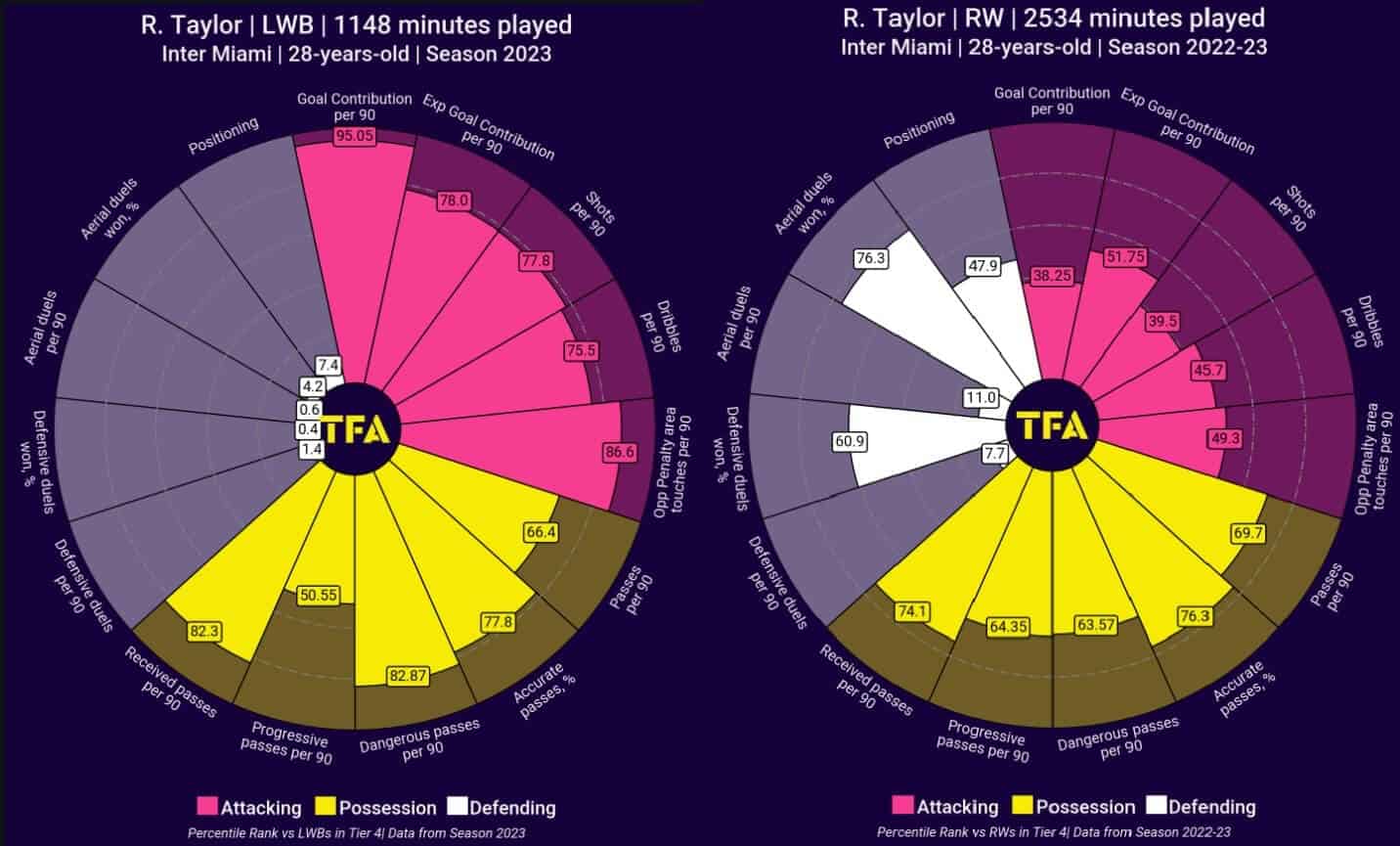
Perusing the statistics, it was quite challenging to find what exactly made Taylor the player he was back then; he was someone who would, at times, be involved in the foundations that preceded goals.
Sometimes, that meant tallying second assists (assists to the actual assists), and sometimes, it would just involve recycling play, retaining the ball, and making sure everything was ticking well.
It’s still important and influential, sure, but nothing to really catch the eye.
Interestingly, he was also a much more hard-working defensive player; as the data analysis clearly suggests, Taylor was more of a defensive asset than an attacking one.
That changed immensely with the turn of the season and the new arrivals.
The player you can see on the left is quite different to the one seen on the right.
In 2023, Taylor is an attacking juggernaut, topping or simply increasing his output in the charts in goal contributions, shots, dribbles and even touches in the opposition’s penalty area.
All of this made him a much different player overall — a more potent and dangerous one, at that.
So what changed?
Fundamentally, Taylor is still the same player, but there are several -or three, to be precise – changes we must mention that contributed to this resurgence relatively late in his career.
Firstly, Phil Neville is no longer the coach of Inter Miami and has been replaced by Tata Martino.
This led to the second change, which was Taylor swapping the right-winger role for that of the left-winger/left wing-back.
The third change, which was also borne out of the first—and to an extent second—change, was the arrival of new and much better players like Messi, Busquets, and Alba.
All of this changed the environment drastically and, in turn, made Taylor the more effective player he is today.
So, let’s dive deeper into the tactics to see all that in action.
Robert Taylor Movement & positioning
One of the core differences between Robert Taylor of 2022 and Robert Taylor of (late) 2023 is the positions he occupies and the movements he makes.
In the data analysis, his right-wing profile was decent overall but not exceptional in any of the mentioned categories.
All of that changed, however, when he swapped over to the other side of the pitch.
As a left-winger or a left wingback, Taylor’s connections became more meaningful and, in turn, more effective.
Robert Taylor Touch Map
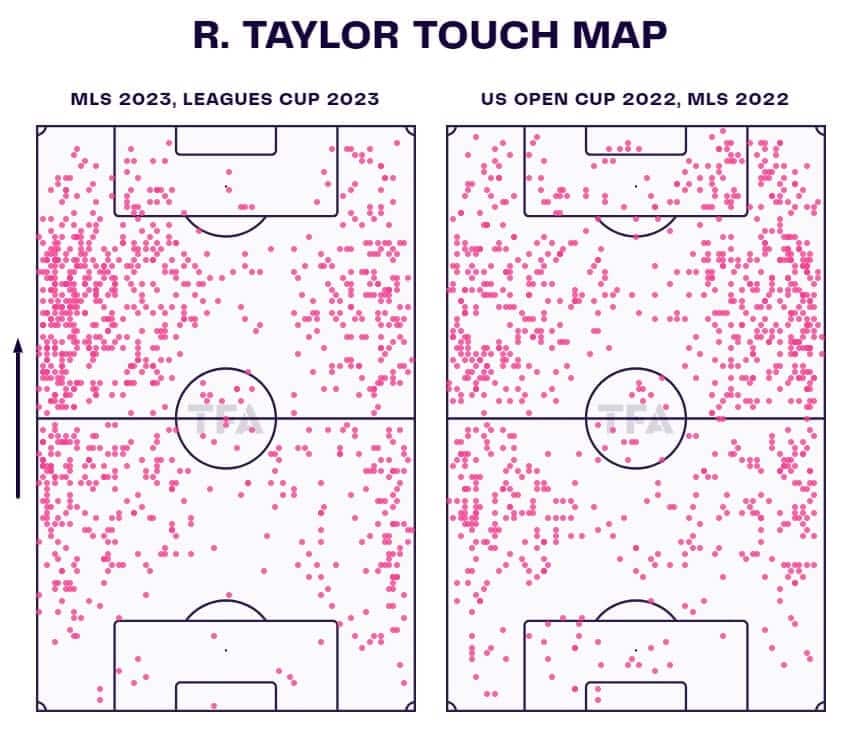
This graph here shows us all of his touches in 2023 (left) compared to all of his touches in 2022 (right).
Naturally, the focus of 2023 is the left wing, but there is also a difference in how he’s used there.
In 2022, he would still occasionally play on the left, but even that change rarely drastically improved his output and efficiency.
Now, however, he is an output machine.
The first thing to notice is the focus on the left half-space.
Taylor is now an inverted presence much more often than not, which plays nicely into the angles he now gets to exploit as a right-footed left-winger.
That particular area gets him closer to the goal and to the connections he can make with his teammates on the pitch.
The role itself, however, is quite versatile in nature; if someone like Alba flanks him, the two can rotate, and Taylor can either provide (initial) width to accommodate Alba’s deeper and inverted distributor role or occupy the half-space to allow the Spaniard the space and the freedom to overlap and deploy deep completions and deep completed crosses into the danger areas.
The two are a stylistically natural fit.
These connections he can now form with the most influential players in Inter Miami’s squad signify his importance and help unlock a much more prominent role for the 228-year-old.
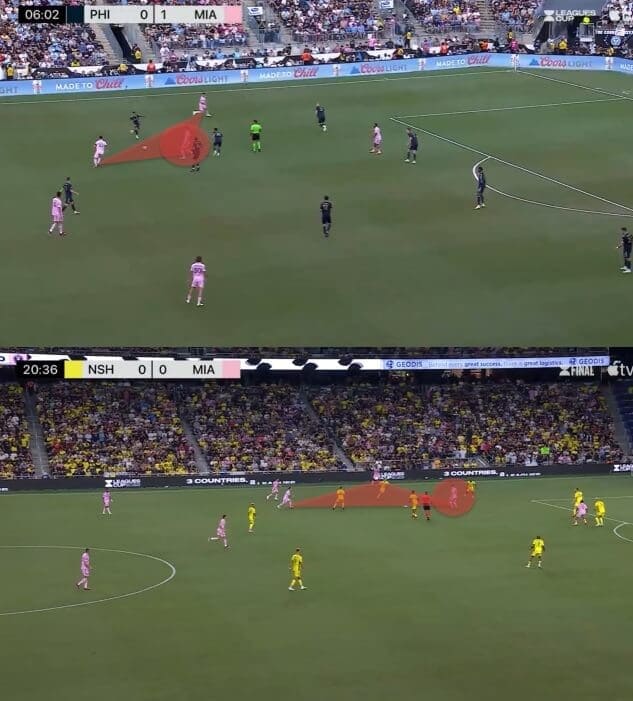
Notice in the latest example how that translates to the on-the-pitch tactics.
Following our analysis, we’ve concluded Taylor often finds himself in the triangle comprising of the left-back (often Alba from now on) and Messi himself, a very esteemed company to keep.
This ties into our rotation discussion earlier in this tactical analysis: Taylor is not just a proxy for Messi and Alba to thrive; he is an active contributor to this relationship.
His movement in possession facilitates and reacts to the players around him, enabling them or freeing them to do what they do best.
Out of possession, he plays to their strengths, making the runs, accessing the channels, and using the vast repertoire someone like Alba or especially Messi brings to the table.
It’s not always the flashiest of jobs, nor is it a glamorous one.
But it’s effective.
Most importantly, however, it rarely shows in the data, so it’s easy to think he’s not doing much simply because he’s not necessarily topping the charts across the board.
Take the following scenarios, for instance.
We know that Messi needs runners around him to be at his best.
Since the Argentine has primarily lost his youthful legs, teams that provide him that through other means often reap the most benefits out of the greatest player to have ever graced the football pitch.
And sometimes, it really is as simple as that.
Run, and Messi will find you.
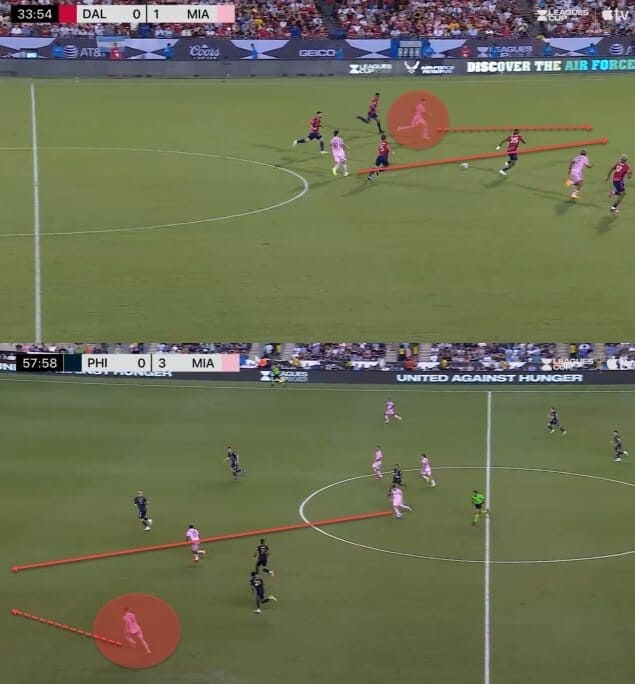
But in 2023, Taylor has become much more than just an enabler; he is at the end of many spectacular goals and, alongside the new signings, a player often in the role of a difference-maker.
Let’s shift our tactical analysis towards that next.
Robert Taylor Goal-scoring threat
Purely statistically speaking, Taylor has never been much of an outlier.
We discussed earlier in the scout report how his 2022 numbers were quite unflattering, to say the least.
And that remains true in 2023 to a large extent.
However, a change is already visible.
Looking at the League’s Cup, which gives us the most prominent sample of Taylor playing alongside the new arrivals and in a new left-winger setup, he ranked fourth in goal contributions with seven (four goals, three assists) and squeezed into the top 10 for expected goal contributions with 3.42.
But this is also where the most impressive data stops; Taylor was incredibly effective but also a massive overperformer.
To tally 10 goal contributions from an expected 3.42 is… Massive.
But also quite possibly unsustainable.
The only player who consistently defied the expected goals and assists metrics is the guy playing close to Taylor these days, a certain Argentine number 10.
But Taylor is no Messi.
No one is.
So, it’s tough to expect him to continue scoring and assisting at this rate so late in his career and for the first time in his career, too.
Still, there is a reason for this resurgence nonetheless.
It probably won’t continue at such a tremendous pace, but it could still continue on an upward spiral, albeit far more dosed.
Robert Taylor Shots Map
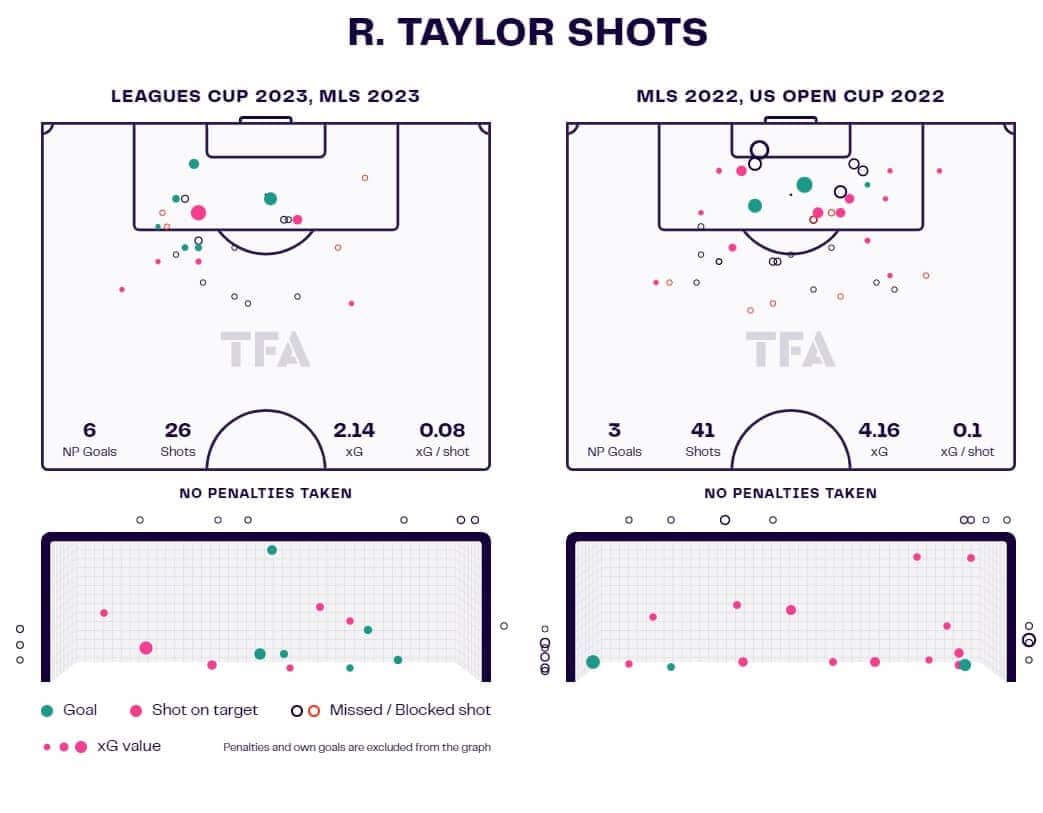
Analysing his shots, their locations and xG values, we can see some differences between 2023 and 2022.
Taylor was never a volume shooter.
Sure, if we compare his League Cup data to just left-backs, left-wingbacks, and left-wingers, he cracks the top 3 in shots but, overall, isn’t in the top 30 in pure total volume or shots per 90 minutes.
He is very effective and precise, registering an impressive 61.54% from 13 total shots, enough to rank 15th in the League’s Cup.
Again, not overly remarkable, but still significant.
The most intriguing part here, however, is the overperformance.
If we compare 2023 to 2022, we see the two main differences in the side of those shots and their conversion rate.
The rest, however, is eerily similar.
Taylor has always been a relatively low xG shooter, courtesy of the problematic positions he chose to shoot from, but that number is even lower in 2023 than in 2022.
But somehow, Taylor has scored far more of such attempts this season than he had the season prior.
His shot locations are very similar, albeit on the opposite side; they come from the top corners of the penalty area and are very low xG compared to the big chances he (sometimes) finds himself in.
But in 2023, he scored six non-penalty goals from 25 shots and 2.4 xG; in 2022, he only recorded three from 41 shots and 4.16 xG.
That makes for fascinating reading.
So what’s behind this?
There are more palpable reasons for it, but also some more ambiguous.
Let’s start with the former.
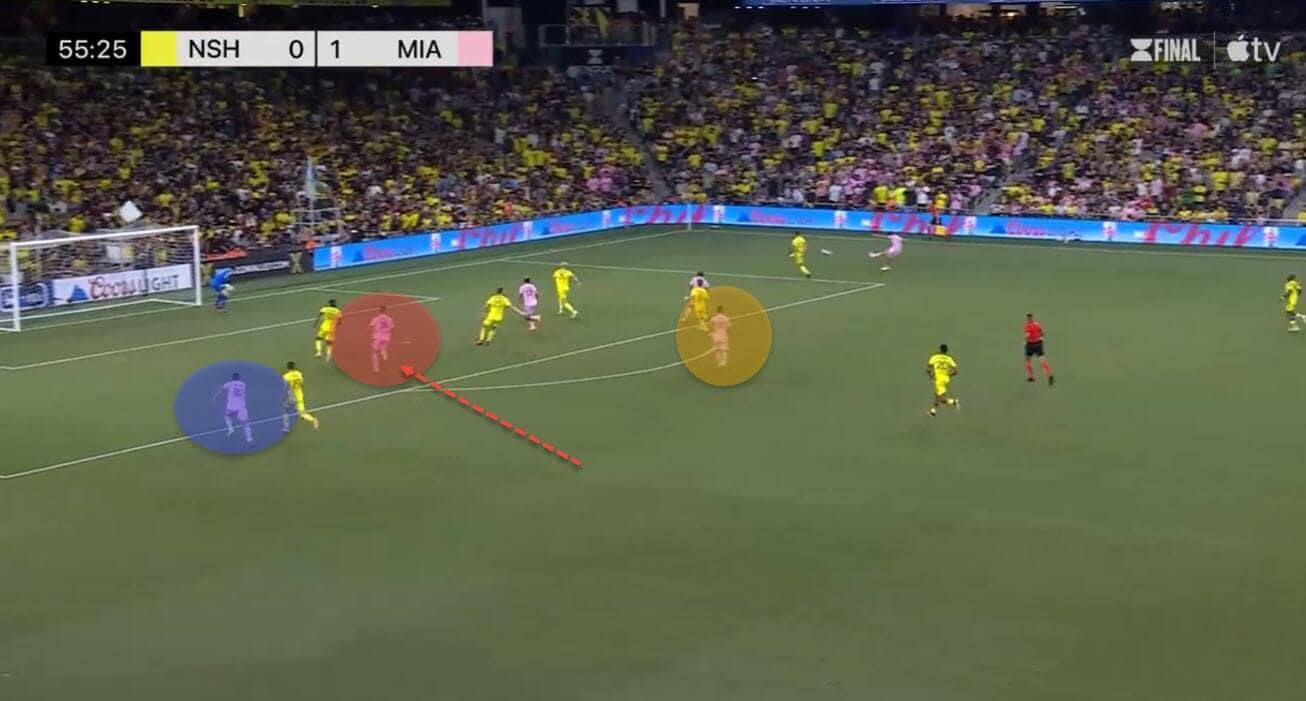
In simplest terms, Taylor has massively benefitted from having elite creators on either side of him.
As alluded to earlier in this scout report, having Messi, Alba and Busquets to your right, left and behind your back, respectively, was bound to elevate him to a higher level overall.
And the change to this inverted role that often puts him close(er) to the goal is just the cherry on top.
As you can see from the latest example here, Taylor can occupy the penalty area and attack it with intensity, knowing a delivery will arrive and he’ll have elite connections all around him.
His shooting positions, as mentioned, are largely the same but on the opposite side.
While this may seem like a small change, it alters the angles at which he can attack the box and attempt the goal.
Sometimes, these attempts will be of higher or lower expected goal value, but overall, they seem to benefit him more on the left side of the pitch.
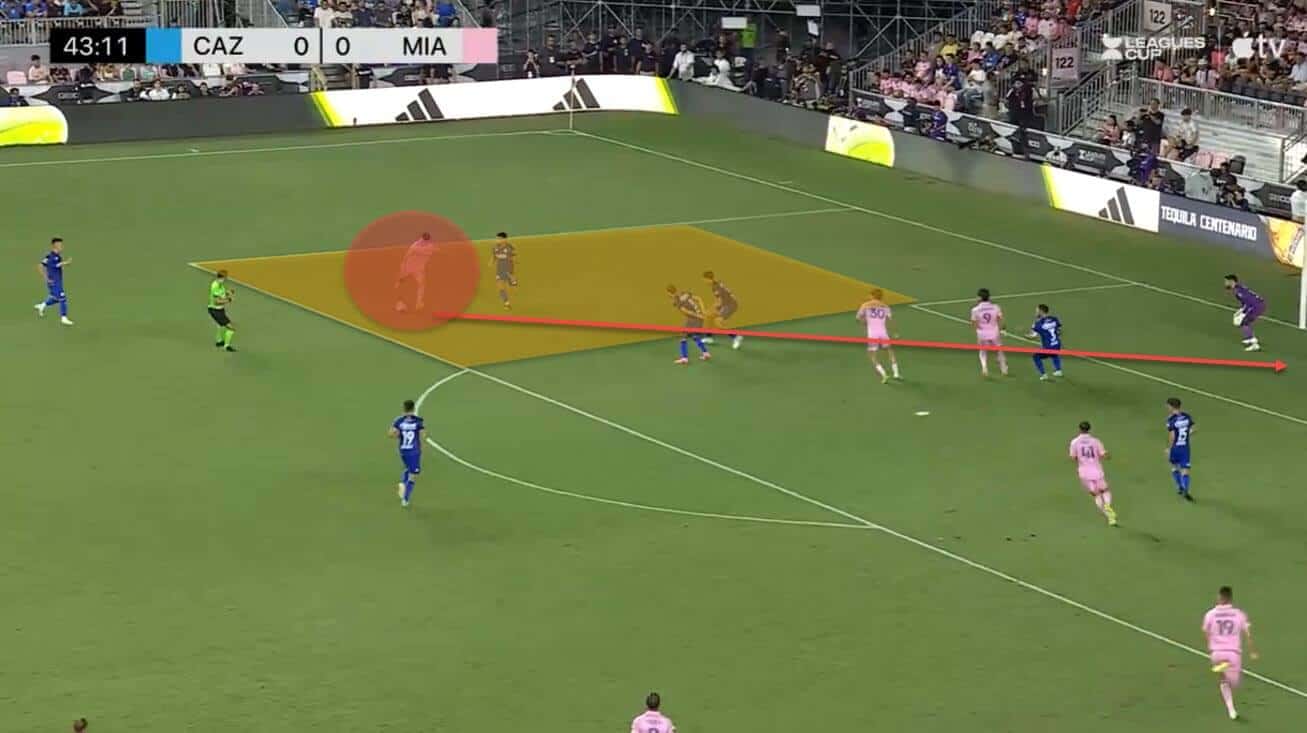
In the latest example, we can see roughly where that area is; he’s positioned just in the top left corner of the opposition’s penalty area, and that’s generally where most of his goals have come from in 2023.
Most have very low xG values, mind you, but somehow Taylor has been able to put them away quite comfortably, showing an impressive skill in ball-striking.
In the League’s Cup, he ranked seventh in the touches in the penalty area category, registering 21 throughout the duration of the competition.
This change in positioning and personnel around him also leads to the more ambiguous aspects mentioned earlier in the analysis.
Imagine the impact the arrival of some of the best players on the planet would have on any team and any player.
The resurgence, optimism, and courage are powerful mental stimulants.
And while there is no way of physically proving this, the increase in output does a pretty good job of it.
Taylor is much more confident, daring and adventurous.
As is the rest of the team.
And fortune favours the bold.
So it’s not entirely ridiculous to state Taylor is also now a luckier and more efficient player because of all those things.
After all, football is a game played with the head.
The creator role
Similarly to Taylor’s goal-scoring output, the foundation of his creativity remained largely the same.
However, some things did change.
For instance, the data analysis alone tells us he receives more passes on average than he used last season and is also delivering more dangerous balls into the final third.
These changes are also caused by the same factors we mentioned at this scout report’s beginning.
In 2022, Taylor was more focused on progressing the ball and switching play from the left half-space or the wide areas on either side of the pitch.
We can see this in the following graphs, too; he likes to make penetrating carries into the box, sure, but the passing is not as intelligent higher up, albeit it does seem to be more prominent in pure volume.
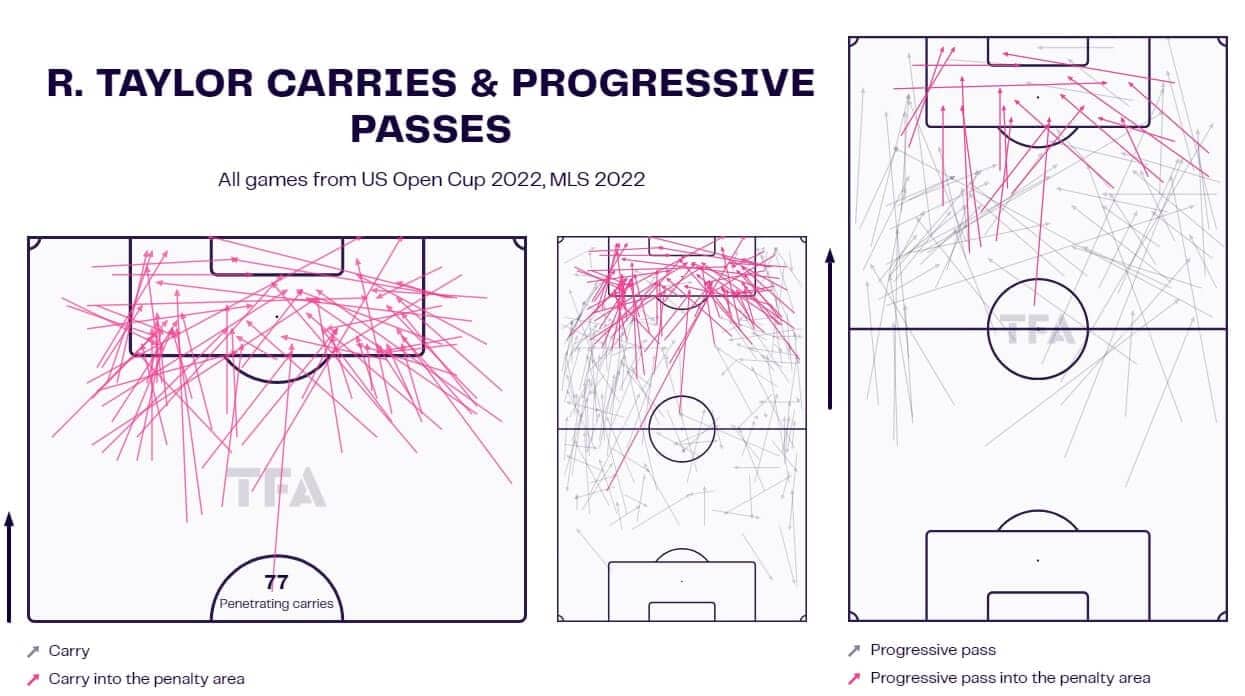
But overall, there weren’t significant changes regarding Taylor’s carries.
In 2022, he recorded touches in the deeper areas, which has continued into 2023 and to the arrival of the new signings and the new coach.
The 28-year-old is involved in the build-up and often drops to receive and lay the ball off to his teammates.
Sadly, it is not necessarily one of his considerable strengths and link or dialogue with the midfield is often of the simplest form.
Of course, this needn’t be a bad thing, but it does signal a slight limitation in his profile.
So, while he does record more received passes than in 2022, 2023 did not see him drastically change or improve in that role.
What it did alter, however, is the focus on dangerous passing from the half-spaces and combination play higher up the pitch with the rest of the forwards around him.
Despite a keen eye for a pass, Taylor isn’t a volume crosser or a dribbler.
Being the team’s creator is far from his primary role in the group.
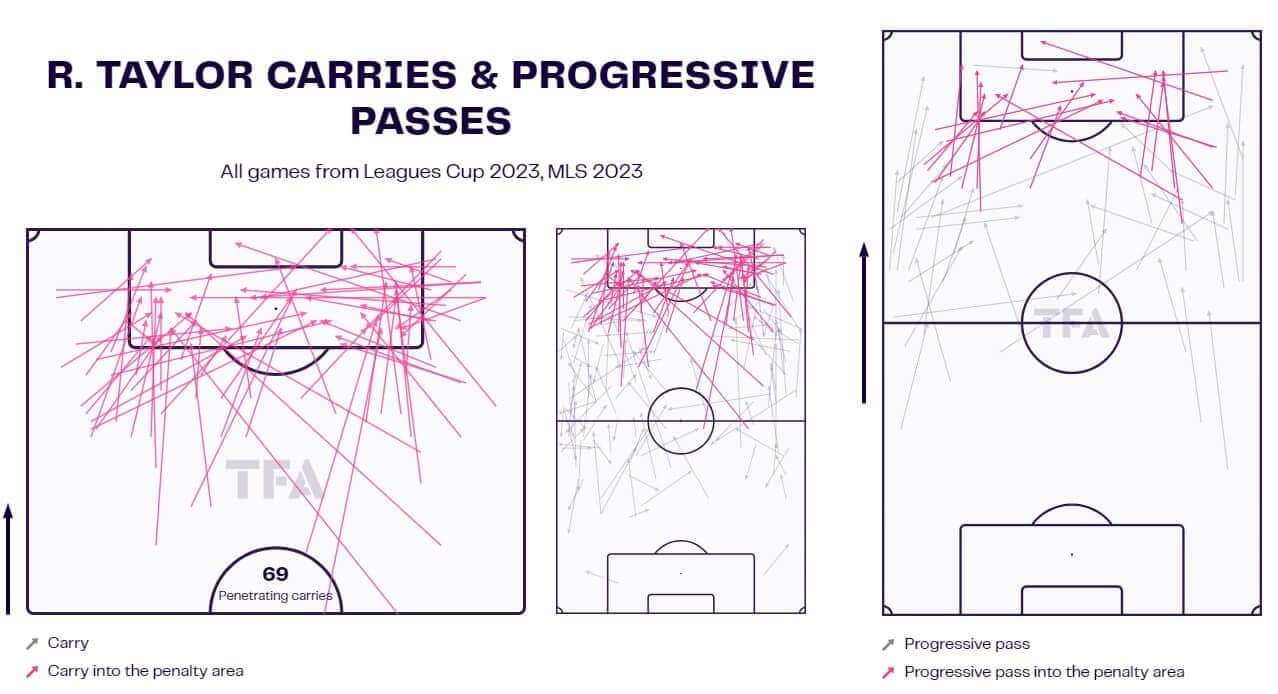
One thing that has recently increased is the deep completions, especially from those half-spaces we’ve mentioned earlier in the analysis.
Taylor seems to be deploying more passes into the danger zones and doing so much more efficiently than before.
During the League’s Cup, he recorded 10 such passes, enough to rank him seventh in the competition.
That was a good enough return for a player whose primary role isn’t that of a creator.
Great even.
Especially considering he tallied three assists as well.
When in this deeper role, Taylor can also deploy longer passes into the space for his teammates.
With the arrival of players like Alba, looking for runners ahead of him could be an excellent way to use his ball striking.
As we’ve seen, it can be pretty good, especially in this new setup and with his newfound confidence.
This creative side of Taylor’s profile can better be seen in his winger actions and shot assists.
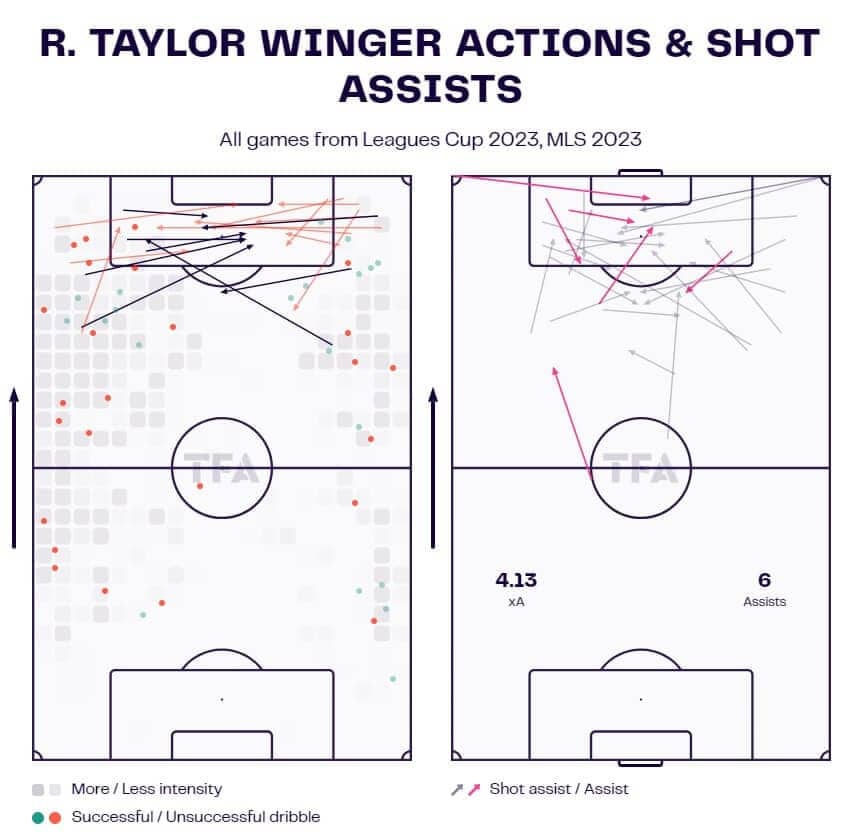
Again, this is where we see his main areas of operation and the intensity of his actions.
It would seem that the same pocket inside the box where he often shoots is also a favourite of his to create from.
That top corner on the left side truly suits his angles really well.
And it also goes hand-in-hand with someone like Messi cutting onto his left foot coming from the right side.
The connection fits once more.
His dribbling seems most effective in the left half-space and, interestingly, on the right side of the pitch.
As a right-footed player, it makes sense for him to be more successful at inverting on the left and then straying more towards the outside on the opposite flank.
In the deeper areas, however, he seems to struggle when heavily marked; Taylor isn’t the most evasive dribbler, and in these instances, he’s far more successful when going for a simple and quick pass to get rid of the ball in congested central zones of the pitch.
It is higher up that his passing gets more deadly anyway.
We have seen him deploy longer passes from the deep, but this specific part of his profile generally shines inside the final third.
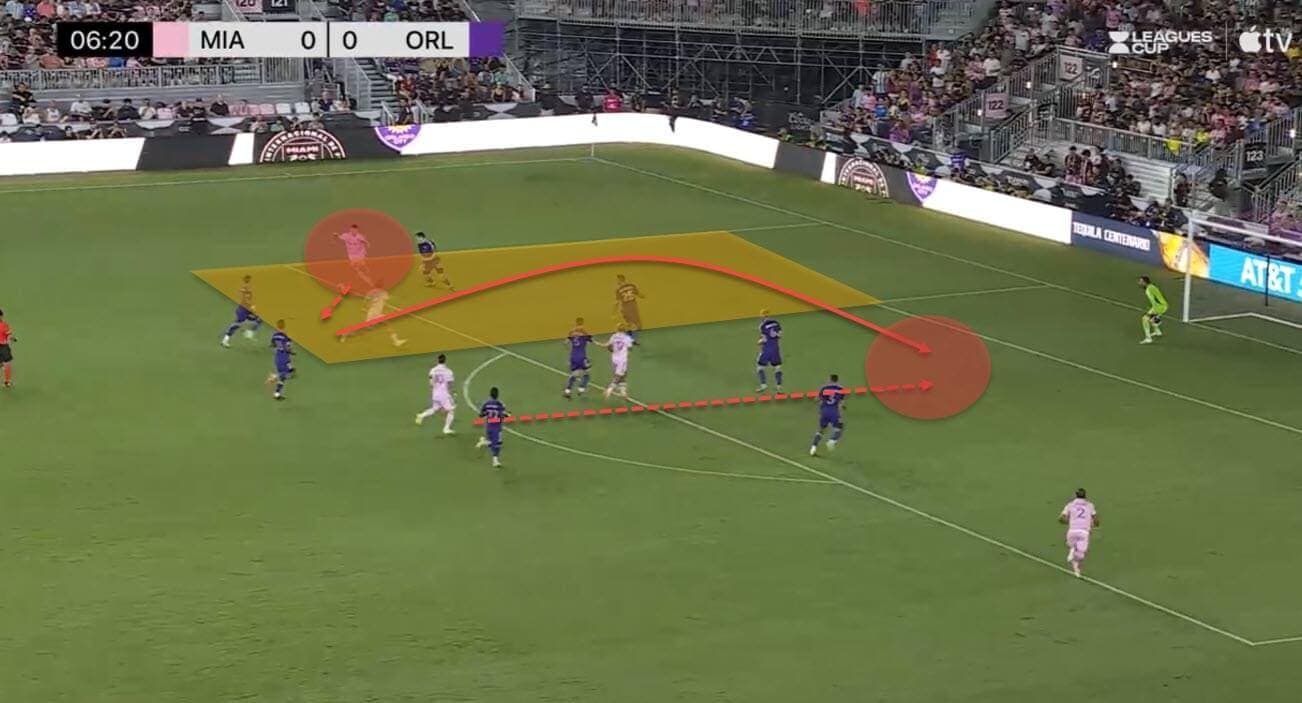
Even more so when he has elite players with great movement close to himself.
Messi, needless to say, is one such player.
Conclusion
Robert Taylor is not a world-beater.
But he is an instrumental piece of the jigsaw whose base attributes were enhanced by the arrival of a new coach, a new position and new and better players.
The 28-year-old’s arsenal isn’t as vast or impressive as some of the best players in the world, but it fits the system and complements his teammates.
In this improved setup and a much more profitable environment, Taylor can simply be more than he typically is.
He may not set the world ablaze with his pure genius and individual brilliance, but he will help others shine as brightly as they can.
And who knows, perhaps he will get to shine somewhere along the way.






Comments